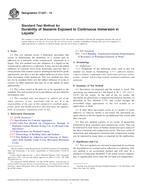We need your consent to use the individual data so that you can see information about your interests, among other things. Click "OK" to give your consent.
ASTM C1247-14
Standard Test Method for Durability of Sealants Exposed to Continuous Immersion in Liquids
STANDARD published on 1.1.2014
The information about the standard:
Designation standards: ASTM C1247-14
Note: WITHDRAWN
Publication date standards: 1.1.2014
SKU: NS-10253
The number of pages: 4
Approximate weight : 12 g (0.03 lbs)
Country: American technical standard
Category: Technical standards ASTM
The category - similar standards:
Annotation of standard text ASTM C1247-14 :
Keywords:
adhesion, liquid immersion, sealant, water immersion, ICS Number Code 91.100.50 (Binders. Sealing materials)
Additional information
| Significance and Use | ||||||||||||
|
5.1 This test method uses elevated temperature to accelerate the degradation of a sealant and its adhesion to a substrate. This test method is an accelerated method and will only be a predictor of long-term durability if the actual service temperature is significantly lower than the elevated test temperature. 5.2 This test method can be used as an indicator of longevity but direct correlation to actual use will be difficult for many applications. 5.3 The correlation of data from this test method to applications where the sealant joint will have wet and dry cycles will be difficult since, with some sealants on some substrates, adhesion that is lost during wet periods is regained during dry periods. 5.4 This test method is performed in a hot liquid and may be considered an acceleration of deterioration of the sealant or the sealant's adhesion to a substrate. Compared to how the sealant will be used in some applications, in some cases, this test may be less severe than the actual application. The benefit from the use of this test method will depend on the comparison of the conditions of this test to the actual conditions of use (temperature, duration, nature of substrate, composition of the liquid). 5.5 To determine the ability of a sealant to perform in a given application; modification of this procedure will often be required and is permissible, as mutually agreed upon by purchaser and seller. |
||||||||||||
| 1. Scope | ||||||||||||
|
1.1 This test method covers a laboratory procedure that assists in determining the durability of a sealant and its adhesion to a substrate while continuously immersed in a liquid. This test method tests the influence of a liquid on the sealant and its adhesion to a substrate. It does not test the added influence of constant stress from hydrostatic pressure that is often present with sealants used in submerged and below-grade applications, nor does it test the added influence of stress from joint movement while immersed. This test method also does not (in its standard form) test the added influence of acids or caustics or other materials that may be in the liquid, in many applications. 1.2 The values stated in SI units are to be regarded as the standard. The inch-pound given in parentheses are provided for information only. 1.3 This standard does not purport to address all of the safety concerns, if any, associated with its use. It is the responsibility of the user of this standard to establish appropriate safety and health practices and determine the applicability of regulatory limitations prior to use. |
||||||||||||
| 2. Referenced Documents | ||||||||||||
|



 Cookies
Cookies
